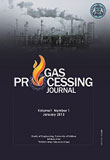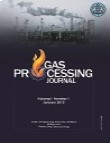فهرست مطالب

Gas Processing Journal
Volume:4 Issue: 1, Winter 2016
- تاریخ انتشار: 1395/02/31
- تعداد عناوین: 6
-
-
Pages 1-28Natural gas is often associated with nitrogen and heavy compounds. The Heavy components in the natural gas not only can feed downstream units, owing to the low temperature process may be formed solid as well. Therefore, heavy components separation can be a necessity and produce useful products. Virtually, all natural gases are containing nitrogen that would lower the heating value of natural gas. Removing nitrogen from natural gas at a concentration of more than 4% can be vital. Integration of the natural gas liquids (NGL), liquefied natural gas (LNG) and nitrogen rejection unit processes is an effective procedure which can reduce the required refrigeration. In the present paper, a novel mixed fluid cascade natural gas liquefaction process is investigated by exergy and exergoeconomic analysis methods. one of the vapor compression cycles is replaced with a water-ammonia absorption refrigeration cycle. The results include cost of exergy destruction, exergoeconomic factor, exergy destruction and exergy efficiency. Results of exergoeconomic analysis indicates that the maximum exergoeconomic factor, which is 89.49%, is related to the HX8 in the water-ammonia absorption refrigeration cycle and the minimum exergoeconomic factor, which is 0.0026%, is related to the HX2 in the liquefaction cycle. In this process, the fourth compressor has the highest exergy destruction cost (5750307 $/hr) and HX8 in the absorption refrigeration cycle has the lowest exergy destruction cost (2.033 $/hr). Due to the high value of fuel cost rate in compressor, their exergy destruction cost is much higher than other devices.Keywords: LNG-NGL-NRU, MFC, Absorption Refrigeration, Exergoeconomic
-
Pages 29-42In this study, it was shown that how CO2 and H2S were removed from a natural gas stream, using a nanofluid containing nanoporous graphene in Diehanolamine (DEA). Before running the experiments, the appropriate values were chosen for the nanosheet dosage and the liquid and gas flow rates in the absorption experiments, which were performed in a laboratory scale wetted wall column. In the experiments, the nanosheet concentration ranged from 0.005 to 0.5 wt %.The surfactants and ultrasonic treatment were used to prepare stable nanofluids. It was indicated that using nanoporous graphene in DEA significantly affects on CO2 and H2S absorption in comparison to DEA. The absolute zeta potential values of nanofluids were greater than mV. The effect of different parameters including nanosheet concentration as well as the CO2 and H2S concentration, in the feed gas stream (two different samples) on simultaneous absorption of H2S and CO2 from CO2-H2S-CH4 gas mixture was studied. In the case of using sample #1, (i.e. Feed gas mixture composition: % H2S and 3% CO2 in balance of CH4), an improvement in CO2 absorption to 39% and H2S absorption to 9% was observed at 0.1 wt% of nanoporous graphene/DEA nanofluids.Keywords: Nanofluid, Wetted Wall Column, Hydrogen Sulfide, Carbon Dioxide, Diethanolamine, Nanoporous Graphene
-
Pages 43-54For energy saving retrofit projects, its economics are usually evaluated in terms of capital investment and payback time. The capital investment is in direct relation to the total heat recovery area of the network and the payback time factor is base on both the area and the energy savings. The debottlenecking is an increased throughput, which can be profitable in economic sense. The combination of these two different objectives leads to a new definition of payback time, which differs, from the simple payback of savings to investment ratio. The correlation among area, energy savings and throughput increase is assessed based on pinch technology. The variation in energy savings and network area with throughput increase considering both economic factors of investment and payback time is reflected in the results. The decomposition approach is implemented as well, and its contribution in rapid detection of the most economical opportunity of network debottlenecking is discussed and the findings are diagramed separately. A visual software code is developed and validated in this study.Keywords: Debottlenecking, Throughput Increase, Pinch Technology, Heat Exchanger Network
-
Visual Observation of Flow Regime Transition in Downward Vertical Gas-Liquid Flow Using Simple MixerPages 53-62Different flow patterns of downward gas-liquid two-phaseflow using simple mixer are studied in an experimental manner. An experimental setup is designed and fabricated to allow the visual observation of downward two-phase flow patterns and their transitions. The flow patterns are recorded by a 1200 frames per second high speed video camera. The quality of downward two-phase flow patterns photos are improved through image processing. The setup includes a transparent vertical pipe of 50 mm diameter and the (L/d) aspect ratio of 80. Flow patterns are obtained through 374 test cases during which air and water superficial velocities changed. In order to assess the performance of the mixer, all expected flow patterns are obtained. The four observed flow regimes are: of falling film, bubbly, slug and froth. The flow map is plotted and transitions among different flow patterns are compared with previous finding in specified conditions indicating a good agreement was observed.Keywords: Two-phase, flow patterns, Simple mixer, Visual observation
-
Pages 63-72The propylene production with 1-butanol co-feeding for methanol in relation to propylene process (MTP) at 440-490 ̊C temperature range and at 0.9-15 hr-1 WHSV range over H-ZSM-5 zeolite catalyst is assessed in a isothermal fixed-bed reactor. The feedings here are of: pure 1-butanol, pure methanol and a 1-butanol and methanol mixture. The effect of 1-butanol co-feeding on selectivity of propylene is assessed through RSM an experimental design method. The results indicate that the selectivity of propylene is 69% in the feed mixture of 13, 37 and 50 wt% of 1-butanol, methanol and water, respectively. The optimum conditions to obtain high level of propylene selectivity is suggested to be at 480 ̊C, WHSV of 0.9 hr-1 and 1-butanol concentration of 0.135 wt.% through RSM method. The sensitivity analysis of the RSM method reveals that the WHSV is the most effective parameter on the propylene selectivity with a P-value of 0.003.Keywords: MTP process, Selectivity, co-feeding, H-ZSM-5 catalyst, RSM
-
Pages 73-82
Positive coupling effect in gas condensate reservoirs is assessed through a pure theoretical approach. A combination of linear stability analysis and long bubble approximation is applied to describe gas condensate coupled flow and relative permeability, thereof. The role of capillary number in gas condensate flow is clearly expressed through closed formula for relative permeability. While the model is intended to give a clear image of positive coupling through comprehensible fluid mechanical arguments, it predicts relative permeability values that are not too far from limited published experimental data presented in the literature. Based on the systematic deviation of the model results from experimental data, it could be expected to serve as a basis for generalized gas condensate relative permeability correlations by including inertial effects in terms of Weber number as discussed in this study. The success of this theoretical approach in describing the role of capillary number and Weber number on gas condensate relative permeability motivates further study of the underlying mechanism of flow coupling in near well-bore region of gas condensate reservoirs in the hope of pure theoretical and yet predictive equations for gas condensate relative permeability.
Keywords: Rlative Permeability, Gas Condensate, Positive Coupling Effect, Capillary Number, Weber Number


